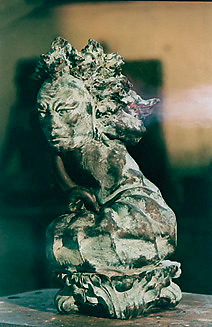The Figure
The Metamorphosis of Medusa
This Sculpture is presently FOR SALE
Please Contact me on my Profile Page BTC and SOL Accepted
Medusa is depicted through four separate portraits each becoming increasingly grotesque as they describe the evolution from mortal to monster.
According to myth, Medusa was one of three sisters whose charge was to guard the entrance to the underworld. It is said that they were a race of warlike women who turned to stone all those who beheld them. Still others say that Medusa was a beautiful woman with magnificent hair, an equal to Athena in beauty. This legend tells of how Poseidon seduced Medusa in the temple of Athena and to punish this act, Athena changed Medusa’s hair into snakes. Later, Perseus was sent to seek her out and return with her head. This series of sculptures portrays an imaginary process in which Medusa transforms in order to defeat her enemies and protect her domain.
The Gorgons were said to be a race of warlike women who turned to stone all those who beheld them, their charge was to guard the entrance to the underworld. They were three sisters Medusa, Stheno and Euryale of whom only Medusa was mortal, and have been described as monstrous creatures covered with impenetrable scales, with hair of living snakes, great tusks like swine’s, brazen hands and golden wings.
The inspiration for this work was found in the archaeological study of Greek and Roman temples, often decorated with the heads of the Gorgons. These portraits in high relief adorned he keystones that crowned many of the arched doorways and portals and were placed upon grave markers to avert the forces of evil and to protect those within from harmful and mischievous spirits. With the rise of the Christianity, these pagan traditions were refuted and the portraits were presented as decorative motifs.
The sculptural work depicts the metamorphosis of Medusa in four stages as she turned from woman to monster. Beginning with a conventional image of a handsome woman, whose hair is adorned with snakes, as described in the early myths. The serpents around her gradually become less abundant as she absorbs them into her changing persona.
The second portrait depicts an increasingly grotesque image more fierce and frightening, involving mystical and imaginative aspects. Her facial features change and eyes become more intense, developing into an intuitive stare seemingly more masculine then feminine.
The third representation changes more dramatically, further distorting the figure and finally leading to the fantastic. The scales of her snake-like body are enlarged giving her a more monstrous, grotesque form as the animalistic characteristics invade her appearance.
The fourth sculpture completes the transformation to serpent and shows her having enveloped the surrounding snakes into her. Her face has been stretched to make her features more prominent and fiendish with the scales and ears of a reptile. Her nose and mouth have flattened while her eyes have taken a more sinister nature, the culminating image may just be frightening enough to turn the viewer to stone
I was excited at the thought that Medusa and her sisters might have been among the original "Gargoyles" whose high relief portraits decorated the keystones, which crowned many of the arched doorways and portals in European architecture. Thus I decided to continue along my earlier theme of Gargoyles that began with the four portraits entitled "The Clefs D’arc". In combination with my interest in mythological figures, a portrait of Medusa, and perhaps her sisters, would be fitting.













